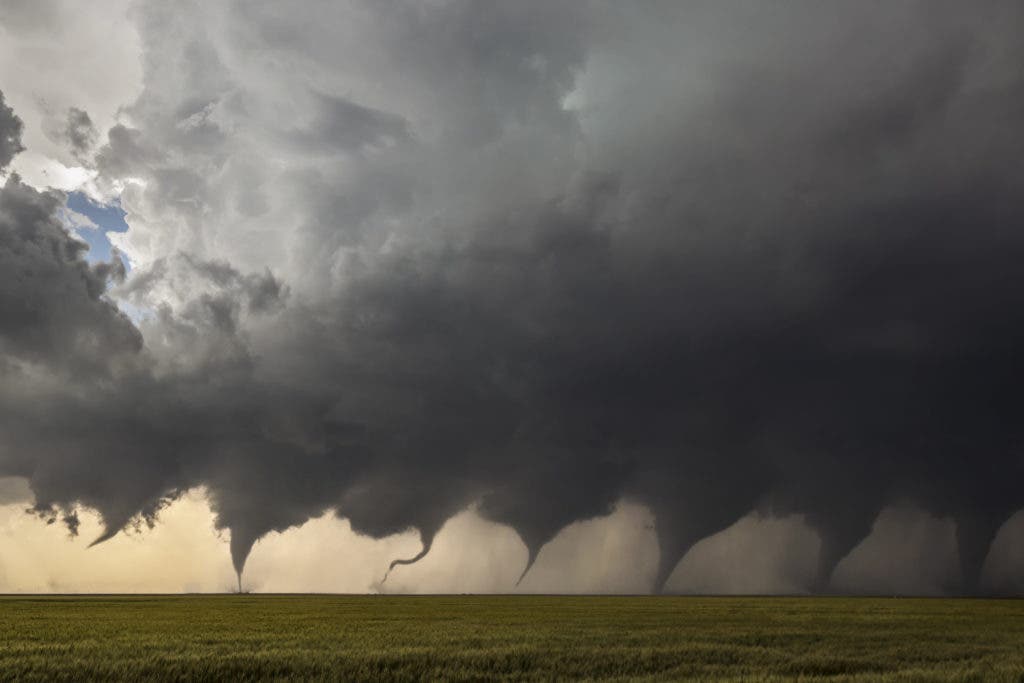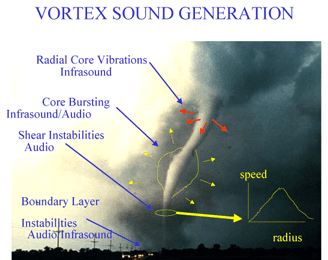Tornadoes can produce infrasounds, and those infrasounds can be used by scientists to “peak in” on the violent phenomena.

Composite of eight images shot in sequence as a tornado forming in Kansas in 2016. Image credits: Jason Weingart / Wikipedia.
A few decades ago, researchers realized that along with the very big ‘boom’, nuclear explosions also produce sounds — some of them at infrasound frequencies. Because infrasounds decay so slowly, they can travel around the Earth several times and can, therefore, be used to track nuclear tests.
Now, researchers are using the same approach to track down tornadoes, using infrasounds. During the 175th Meeting of the Acoustical Society of America, Brian Elbing, assistant professor of mechanical and aerospace engineering at Oklahoma State University, says that we can predict when and how a tornado will form, using infrasound detectors.
Tornado-producing storms can emit infrasound more than an hour before “tornadogenesis,” or tornado formation. Picking up on these waves could improve the accuracy of tornado alerts.
“By monitoring tornadoes from hundreds of miles away, we’ll be able to decrease false alarm rates and possibly even increase warning times,” Elbing said. “It also means storm chasers won’t need to get so close.”
[panel style=”panel-default” title=”Tornado formation” footer=””]No two tornadoes are the same, but all tornadoes require on specific conditions to form.
It starts when sunshine heats the ground, which causes pockets of air to rise. If the atmosphere is unstable, the pockets can rise to great heights, resulting in the development of much deep, strong currents of ascending air (updraughts) and storm clouds.
If the atmospheric winds are strong enough, the stormy updraughts can start to rotate, and tilt to become vertical.
Eventually, the rotation may become so strong that a narrow column of violently rotating air forms — thus, a tornado is born.[/panel]

An illustration of generation of infrasound in tornadoes by the Earth System Research Laboratory’s Infrasound Program.
In order to do this, Elbing and his team deployed three infrasound microphones arranged in a triangle, each spaced about 200 feet apart. The key features of these microphones are their ability to zoom in on very specific frequencies and to filter out any unwanted noise.
“First, these are larger for greater sensitivity to lower frequencies,” Elbing said. “Second, we need to get rid of wind noise. … We seal the microphone inside a container with four openings. A soaker hose — just like the ones used in gardens — is attached to each of these openings and stretched out in opposite directions.”
Of course, this would work best in areas which are prone to tornado formation, improving the alarm systems. A significant problem in such tornado-prone areas is that most tornado alarms are false — and as a result, are often ignored. With the infrasound technology, authorities could issue accurate alarm warnings and save lives. To make things even better, it can be used in tandem with existing technologies.
“Since infrasound is an independent data source, combining it with existing methods should help reduce false alarms,” said Elbing. “Today, 75% of tornado warnings are false alarms and tend to be ignored.”
Researchers already have their eyes on a particular test zone: Dixie Alley — the areas of the southern United States that are particularly vulnerable to strong or violent tornadoes. From there on, the technology could be deployed in much greater areas such as the infamous Tornado Alley.
“This is especially true for Dixie Alley, which isn’t known for the largest tornadoes but frequently has the most fatalities,” Elbing said. “Complex terrain, irregular road patterns, and nighttime tornadoes prevent storm chasers from observing these tornadoes, so long-range, passive monitoring for tornadoes will provide invaluable information about their formation processes and life cycle.”
Results have not yet been peer-reviewed.









